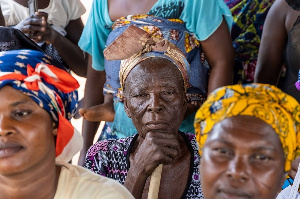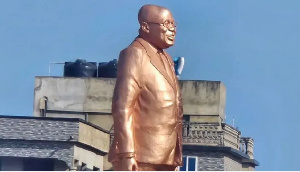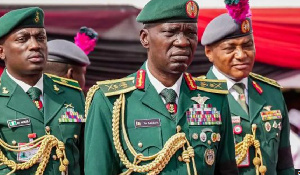Opinions of Thursday, 5 October 2023
Columnist: Issifu Seidu Kudus Gbeadese
Re-identifying the indigenous identity - The 'Settle Ghana' methodology
To form and operate an effective government is to maintain and jealously guard the social contract between the citizens and the government. Within the context of this arrangement, the government is required not only to unreservedly guarantee fundamental human rights but to protect same by consciously putting in place structures and institutions that will ensure that these rights are protected and respected without any room for discrimination and selective
application of whatever form.
In this regard, all persons, irrespective of their cultural, religious, social, or political backgrounds must be given the same and equal treatment. The duty imposed on the government, therefore, is to craft policies aimed at protecting and advancing the interest of minorities, the vulnerable, the weak and the marginalized in society. This is why, states and governments in some cases are required to make and implement specific laws and regulations aimed at protecting the above-mentioned groups.
So, it was only reasonable that the United Nations General Assembly in September 2007 adopted the United Nations Declaration on the Rights of Indigenous Peoples (UNDRIP)—imposing a duty on member states to guarantee and protect the rights of indigenous people.
It is worth noting that there are over 370 million indigenous peoples in different regions of the world, occupying about one-fifth of the earth's surface. Many of these people face extreme situations of marginalization perpetuated by governments and other organized and relatively strong organizations and institutions. Unfortunately, due to political, pragmatic, and other reasons, these actors (states and non-states) are reluctant to provide an official definition to such people due to possibly undesirable legal, political, and other consequences such a definition will entail.
This has left the gate open for various actors to explore and assign such
terms like “indigenous peoples”, “indigenous populations”, “autochthonous populations”, “aboriginal peoples”, “tribal peoples”, “fourth world”, and “titular nations”, etc. to refer to these people. These different sets of labels have created extreme difficulty in determining who is “indigenous” in comparison with the rest of the population in modern conditions. Thus, any definition developed based on a set of criteria common to all states might trigger
undesirable consequences.
During the round table discussions of the Working Group on the Draft UN Declaration on the Rights of Indigenous Peoples, government delegations expressed the view that it was neither appropriate nor necessary to develop a universal definition of indigenous peoples. In addition, some state's reluctance to provide a regime of rights granted by international law to indigenous peoples, avoid any generally accepted definition.
The lack of a definition of the term allows such states to deny the presence of indigenous peoples on their territories, who, in their opinion, are subject to preferential treatment by the rest of the population. In some instances, the indigenous peoples themselves are not enthused with a “one-size-fits-all”
definition, perhaps, they fear that such a definition may deny certain groups indigenous status when such groups of peoples may be indigenous peoples. Nevertheless, the UN recognized the right of peoples to self-determination and adopted the Declaration on the Rights of Persons Belonging to National or Ethnic, Religious, and Linguistic Minorities.
Amid all these uncertainties about the definition of “indigenous peoples”, Jose’ Martinez Cobo attempted a definition that has become the most widely cited. In his 1983 Report on the Study of the Problem of Discrimination Against Indigenous Populations, Cobo couched his definition, thus, “Indigenous communities, peoples and nations are those which, having a historical continuity with pre-invasion and pre-colonial societies that developed on their territories, consider themselves distinct from other sectors of the societies now prevailing in those territories, or parts of them. They form at present non-dominant sectors of society and are determined to preserve, develop, and transmit to future generations their ancestral territories, and their ethnic identity, as the basis of their continued existence as peoples, by their cultural patterns, social institutions, and legal systems.” (UN Doc. E/CN.4/Sub.2/1983/21/Add.8, paras. 379-80 (1983).
Other definitions of the term in literature are generally similar to the definition proposed by Cobo. James Anaya for example defined indigenous peoples as “living descendants of pre-invasion inhabitants of lands now dominated by others. They are culturally distinct groups that find themselves engulfed by other settler societies born of forces of empire and conquest” (See Anaya, J. (2004) Indigenous Peoples in International Law (2nd ed.). Oxford University Press. P. 3).
The complexities associated with globalization, uncertainties of the modern global markets, the insatiable quest for exploitation of natural resources, and the unfettered growth of governmental power over citizens have undoubtedly left the “indigenous peoples” disadvantaged and at worse shortchanged in several ways.
For instance, in a conscious effort by some states and non-state actors to extinct indigenous peoples and their systems, their status in most cases is craftily determined based on outdated cultural traditions, and this is certainly disadvantageous. This label seriously constrains indigenous groups to exercise their right to self-determination, which may include the desire to
abandon historical traditions and adapt their culture in certain ways to allow them to successfully and conveniently coexist with the modern world around them.
It is absurd that “indigenous” groups have to “reconfigure their ethnic identity or maintain some sort of indigenous cultural authenticity” to gain recognition. For example, “The San must still act as true “Bushmen” to satisfy a land claim, otherwise, judges may rule their identities as false and opportunistic. While, for example, “English people” are not expected to express their English identity, although being “English” allows one to simultaneously be “modern” and lay claim to an idealized English past of kings and queens, castles, medieval
villages and pastoral landscapes.”
It must be emphasized that in many jurisdictions in Asia and Africa, the term “indigenous peoples” evokes feelings of the past, juxtaposing European imperialists against colonized peoples. In such settings, “indigenous peoples” are seen as populations that are currently the original inhabitants but are dominated by European (foreign) settler populations. Where such conditions no longer exist due to decolonization, some believe that the concept under
discussion is no longer applicable.
Given the diversity of opinions, particularly among States, on the issue of “indigenous peoples,” international standard-setting mechanisms and indigenous peoples themselves support a rights-based approach to the concept rather than an emphasis on indigenous peoples. As a result of active participation in the UN and regional mechanisms for the protection of human rights, indigenous peoples themselves have advocated the criterion of “self-identification” as a tool for determining their status. The said “self-identification” can be defined as the right of individuals and groups to identify and proclaim their indigenous identity, regardless of the permission of any certifying institution at any level, either by a local community, a “host” state, or an international organization.
It is therefore no surprise that the rights of indigenous peoples to self-identify as such has been proclaimed in international legal documents, including in particular the UN Declaration on the Rights of Indigenous Peoples. Out of the 49 Articles of the UNDRIP, Articles 5, 8, and 10 have espoused the rights of indigenous people by recognizing the urgent need to respect and promote their inherent rights especially, the rights to their unassimilated culture, lands, territories, and resources.
In this regard, Article 5 states that, “indigenous peoples have the right to maintain and strengthen their distinct political, legal, economic, social and cultural institutions, while retaining their rights to participate fully, if they so choose, in the political, economic, social and cultural life of the state.” Also, Article 8 states thus, “indigenous people and individuals have the right not to be subjected to forced assimilation or destruction of their culture.
Further to this, article 10 conspicuously states, “Indigenous peoples shall not be forcibly removed from their lands or territories. No relocation shall take place without the Free, Prior, and Informed Consent (FPIC) of the indigenous peoples concerned and after agreement on just and fair compensation and after agreement on just and fair compensation and, where possible, with the option of return.”
In particular reference to Article 10, the member states are obliged to recognise the institutionalization of FPIC about taking the lands and exploiting the resources of indigenous peoples. It is therefore mandatory for a dualist state like Ghana which is a signatory to the UNDRIP and the UN Conventions at large, to domesticate and give FPIC and enabling legislation to effectuate the realization of the rights of indigenous peoples particularly their rights to give or withhold consent to the exploitation of their resources, taking of their lands or the execution of some infrastructure projects which will have ultimate dire consequences on their lives as espoused by Article 10.
It is in this light, that Settle Ghana, a Ghanaian-based Non-governmental Organization to promote, defend, and advocate for the rights of indigenous people has made it a priority to advocate for Free, Prior, and Informed Consent (FPIC) to be made law in Ghana. When legislated, FPIC will guide Ghana to fully adhere to the dictates of Article 19 of the UNDRIP which states that, “member states shall consult and cooperate in good faith with the
indigenous peoples concerned through their representative institutions to obtain their Free, Prior and Informed Consent before adopting and implementing legislative or administrative measures that may affect them.”
Free, Prior, and Informed Consent (FPIC) is aimed at establishing bottom-up participation and consultation of an indigenous population before the beginning of development on ancestral land or exploitation of resources in an indigenous population's territories. To protect Indigenous Peoples' rights, international human rights law has created processes and standards to safeguard their way of life and to encourage participation in the decision-making process,
and one such method is FPIC.
Incorporated in 2019, Settle Ghana has undertaken vigorous campaigns, education, and awareness creation in indigenous communities in Ghana on their rights under the UNDRIP; and how to negotiate with government and multi-national organizations. While at this Settle Ghana is consistently advocating for FPIC to be made law in Ghana. Led by its Executive Director, Mr. Abu Karimu, Settle Ghana through its “Walking Together Initiative”, and in collaborations with ASI and Alcoa Foundation (the funding agency), has completed two projects in this
regard.
The two projects were executed in 6 regions in Ghana. The aim is to promote sustainable development and economic opportunities in indigenous communities across Ghana. Given this, FPIC was used as a tool to empower indigenous people in Ghana to participate in decision-making processes that impact their lands and livelihoods. During the first stage of the Walking Together Initiative in 2022, Settle Ghana conducted FPIC Roadshows in these communities, engaging with community elders, members of the communities, and key stakeholders like
Assembly Members to identify key issues and threats to their livelihoods.
These engagements with community members and village elders during the first stage provided a comprehensive understanding of the challenges facing these communities. The second stage of the Walking Together Initiative conducted extensive community engagements. With a different module of FPIC, about 4,400 indigenous peoples were engaged in the six regions. Having identified the challenges facing these communities during the first stage of the initiative, Settle Ghana in addition to these engagements in the second stage created a vehicle meant to deliver alternative livelihood micro-projects for these communities.
In light of this, the organization provided some educational materials including school furniture, exercise books for school children, and some computers for Adukrom in the Eastern Region and Kamenga in the Upper East Region. Also, the organization successfully installed solar panel streetlights in the Awaso community in the Western-North Region.
Settle Ghana recognizes how sophisticated the world is becoming coupled with globalization and its attendant consequences on the lives of indigenous peoples. The organization is also cognizant of the existential threats of climate change to the ecosystem and indigenous territories at large, caused by unapproved mining methods and activities, bad farming practices, and indiscriminate carbon emission, among others. Lastly, given our engagement with indigenous communities, we have noted with grave concern, the fast rate at which indigenous peoples are losing their cultural identities (i.e. their languages, food, dress code, etc.) and their indigenous institutions to modernization.
In finding a solution to the above, the organization has adopted yet another indigenous, participatory approach, re-identifying the indigenous identity by re-inventing the old way of living. The organization has designed a tool (THEN and NOW) that seeks to draw a connection with the ancestry of the indigenous peoples. The questions we are asking are: how did the forefathers of these indigenous people live and relate to their environment? How were the forefathers able to protect and guard their indigenous institutions from adulterations and assimilation?
Where is the missing link between Then and Now? Settle Ghana believes that
answers to the above and many others will set the path for the indigenous peoples and communities to re-identify themselves and protect their cultural identities, environments, and indigenous institutions. As usual, Settle Ghana designed the above tool around FPIC.
We, Settle Ghana, duly recognize that Ghana is a dualist state whose Municipal Laws take precedence over International Laws, and until the latter is given enabling legislation through the process set out in Article 75 of the 1992 Constitution of Ghana, they cannot be directly applied in the domestic setting. The Organization equally takes note of the importance of the provision in Article 257(6) of the 1992 Constitution, which states thus, “Every mineral in its natural state in, under or upon any land in Ghana, rivers, streams, water courses throughout Ghana, the exclusive economic zone and any area covered by the territorial sea or continental shelf is the property of the Republic of Ghana and shall be vested in the President on behalf of, and in trust for the people of Ghana.”
The above notwithstanding, we believe that nothing of any form or kind should stand between the people and their fundamental human rights, in this case, the rights of the indigenous people as captured by UNDRIP and the 1992 Constitution of Ghana. It is on this note that Settle Ghana is not reneging on its core duty to keep advocating for FPIC TO MADE LAW IN GHANA. It is our honest belief that Peru, Australia, and the Philippines equally have similar provisions in their laws yet, they have included FPIC in their national laws.
Entertainment










